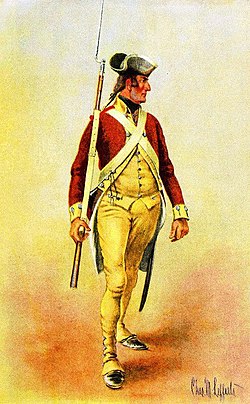1st Pennsylvania Regiment
| 1st Pennsylvania Regiment | |
|---|---|

1st Pennsylvania Battalion, 1775-1776
|
|
| Active | 1775–1783 |
| Allegiance | Continental Congress of the United States |
| Type | Infantry |
| Part of | Pennsylvania Line |
| Nickname(s) | Pennsylvania Rifle Regiment, 1st Continental Regiment |
| Motto(s) | I Refuse To Be Subjugated |
| Engagements |
Battle of Trenton Second Battle of Trenton Battle of Princeton Battle of Brandywine Battle of Matson's Ford Battle of Germantown Battle of Monmouth Battle of Springfield Battle of Stony Point |
| Commanders | |
| Notable commanders |
Colonel William Thompson Colonel Edward Hand Colonel James Chambers |
The 1st Pennsylvania Regiment, also known as the 1st Pennsylvania Rifles, 1st Pennsylvania Battalion, Pennsylvania Rifle Regiment, and 1st Continental Regiment, was raised under the command of Colonel William Thompson for service in the Continental Army.
The Congressional resolution of June 14, 1775, authorized ten companies of expert riflemen to be raised for one-year enlistments as Continental troops. Maryland and Virginia were to raise two companies each, and Pennsylvania six. Pennsylvania frontiersman, however were so eager to participate that on June 22 Pennsylvania's quota of companies was increased to eight, organized as a regiment known as the "Pennsylvania Rifle Regiment." A ninth company was added to the regiment on July 11. All thirteen companies were sent to Washington's army at Boston for use as light infantry and later as special reserve forces.
Seven companies of the regiment (1st, 2nd, 3rd, 4th, 5th, 8th, and 9th) were made up of mostly Scots-Irish; the 6th and 7th companies were mostly German, from Berks and Northampton counties. Their standard weapon was the long rifle, which had greater range and accuracy than the muskets used by most of the British Army and Continental Army, but less weight of shot, slower rate of fire, and were without bayonets, making the regiment unsuitable for line-of-battle.
Doctor James Thacher, a young doctor from Barnstable who observed the regiment during many of its battles, provided this description of the riflemen:
They are remarkably stout and hardy men; many of them exceeding six feet in height. They are dressed in white frocks or rifle shirts and round hats. There men are remarkable for the accuracy of their aim; striking a mark with great certainty at two hundred yards distance. At a review, a company of them, while in a quick advance, fired their balls into objects of seven inches diameter at the distance of 250 yards . . . their shot have frequently proved fatal to British officers and soldiers who expose themselves to view at more than double the distance of common musket shot. (Source: James Thacher, "Military Journal during the American Revolutionary War from 1775 to 1783".)
...
Wikipedia
